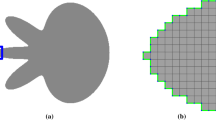Abstract
We introduce a new segmentation method based on second-order energies. Compared to the related works it has the significantly lower computational complexity O(NlogN). The increased efficiency is achieved by integrating curvature approximation into a new bidirectional search scheme. Some heuristics are applied in the algorithm at the cost of exact energy minimisation. Our novel pseudo-elastica core algorithm is then incorporated into a user-guided segmentation scheme which represents a generalisation of classic first-order path-based schemes to second-order energies while maintaining the same low complexity. Our results suggest that, compared to first-order approaches, it scores similar or better results and usually requires considerably less user-input. As opposed to a recently introduced efficient second-order scheme, both closed contours and open contours with fixed endpoints can be computed with our technique.
Access this chapter
Tax calculation will be finalised at checkout
Purchases are for personal use only
Preview
Unable to display preview. Download preview PDF.
Similar content being viewed by others
References
Kass, M., Witkin, A., Terzopoulos, D.: Snakes: Active contour models. IJCV 1(4), 321–331 (1988)
Caselles, V., Kimmel, R., Sapiro, G.: Geodesic active contours. IJCV 22(1), 61–79 (1997)
Cohen, L.D., Kimmel, R.: Global minimum for active contour models: A minimal path approach. IJCV 24(1), 57–78 (1997)
Sethian, J.: A fast marching level set method for monotonically advancing fronts. Proc. National Academy of Sciences 93, 1591–1595 (1996)
Boykov, Y., Kolmogorov, V.: Computing geodesics and minimal surfaces via graph cuts. In: Proc. ICCV 2003 (2003)
Appleton, B., Talbot, H.: Globally optimal geodesic active contours. Journ. of Math. Imag. and Vis. 23(1), 67–86 (2005)
Schoenemann, T., Cremers, D.: Introducing curvature into globally optimal image segmentation: Minimum ratio cycles on product graphs. In: Proc. ICCV 2007 (2007)
Schoenemann, T., Kahl, F., Cremers, D.: Curvature regularity for region-based image segmentation and inpainting: A linear programming relaxation. In: Proc. ICCV 2009 (2009)
El-Zehiry, N.Y., Grady, L.: Fast global optimization of curvature. In: Proc. CVPR 2010 (2010)
El-Zehiry, N.Y., Grady, L.: Optimization of weighted curvature for image segmentation (2010) (preprint), arXiv:1006.4175v1 [cs.CV]
Dijkstra, E.: A note on two problems in connexion with graphs. Num. Math. 1, 269–271 (1959)
Krueger, M.: Segmentation of Surfaces Using Active Contours. PhD thesis, The University of Auckland (February 2011)
Bennett, J.R., MacDonald, J.S.: On the measurement of curvature in a quantized environment. IEEE Transactions on Computers 24(8), 803–820 (1975)
Pohl, I.: Bi-directional search. Machine Intelligence 6, 127–140 (1971)
Mumford, D.: Elastica and computer vision. In: Bajaj, C. (ed.) Algebraic Geometry and its Applications, pp. 491–506. Springer, New York (1994)
Windheuser, T., Schoenemann, T., Cremers, D.: Beyond connecting the dots: A polynomial-time algorithm for segmentation and boundary estimation with imprecise user input. In: Proc. ICCV 2009 (2009)
Ardon, R., Cohen, L.D.: Fast constrained surface extraction by minimal paths. IJCV 69(1), 127–136 (2006)
Author information
Authors and Affiliations
Editor information
Editors and Affiliations
Rights and permissions
Copyright information
© 2011 Springer-Verlag Berlin Heidelberg
About this paper
Cite this paper
Krueger, M., Delmas, P., Gimel’farb, G. (2011). Efficient Image Segmentation Using Weighted Pseudo-Elastica. In: Real, P., Diaz-Pernil, D., Molina-Abril, H., Berciano, A., Kropatsch, W. (eds) Computer Analysis of Images and Patterns. CAIP 2011. Lecture Notes in Computer Science, vol 6854. Springer, Berlin, Heidelberg. https://doi.org/10.1007/978-3-642-23672-3_8
Download citation
DOI: https://doi.org/10.1007/978-3-642-23672-3_8
Publisher Name: Springer, Berlin, Heidelberg
Print ISBN: 978-3-642-23671-6
Online ISBN: 978-3-642-23672-3
eBook Packages: Computer ScienceComputer Science (R0)




